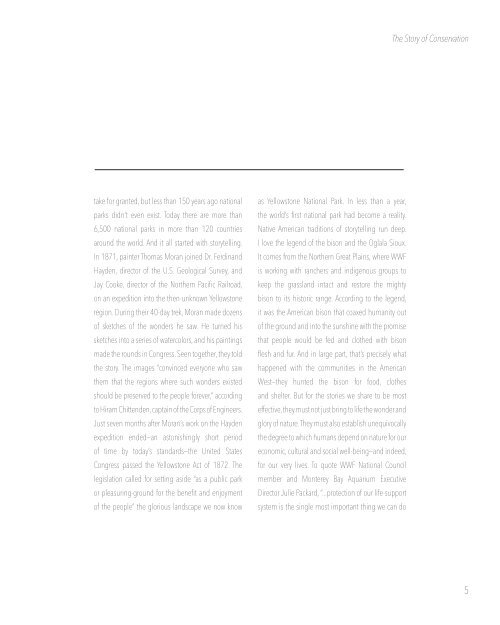WWF Annual Report
You also want an ePaper? Increase the reach of your titles
YUMPU automatically turns print PDFs into web optimized ePapers that Google loves.
The Story of Conservation<br />
take for granted, but less than 150 years ago national<br />
parks didn’t even exist. Today there are more than<br />
6,500 national parks in more than 120 countries<br />
around the world. And it all started with storytelling.<br />
In 1871, painter Thomas Moran joined Dr. Ferdinand<br />
Hayden, director of the U.S. Geological Survey, and<br />
Jay Cooke, director of the Northern Pacific Railroad,<br />
on an expedition into the then-unknown Yellowstone<br />
region. During their 40-day trek, Moran made dozens<br />
of sketches of the wonders he saw. He turned his<br />
sketches into a series of watercolors, and his paintings<br />
made the rounds in Congress. Seen together, they told<br />
the story. The images “convinced everyone who saw<br />
them that the regions where such wonders existed<br />
should be preserved to the people forever,” according<br />
to Hiram Chittenden, captain of the Corps of Engineers.<br />
Just seven months after Moran’s work on the Hayden<br />
expedition ended—an astonishingly short period<br />
of time by today’s standards—the United States<br />
Congress passed the Yellowstone Act of 1872. The<br />
legislation called for setting aside “as a public park<br />
or pleasuring-ground for the benefit and enjoyment<br />
of the people” the glorious landscape we now know<br />
as Yellowstone National Park. In less than a year,<br />
the world’s first national park had become a reality.<br />
Native American traditions of storytelling run deep.<br />
I love the legend of the bison and the Oglala Sioux.<br />
It comes from the Northern Great Plains, where <strong>WWF</strong><br />
is working with ranchers and indigenous groups to<br />
keep the grassland intact and restore the mighty<br />
bison to its historic range. According to the legend,<br />
it was the American bison that coaxed humanity out<br />
of the ground and into the sunshine with the promise<br />
that people would be fed and clothed with bison<br />
flesh and fur. And in large part, that’s precisely what<br />
happened with the communities in the American<br />
West—they hunted the bison for food, clothes<br />
and shelter. But for the stories we share to be most<br />
effective, they must not just bring to life the wonder and<br />
glory of nature. They must also establish unequivocally<br />
the degree to which humans depend on nature for our<br />
economic, cultural and social well-being—and indeed,<br />
for our very lives. To quote <strong>WWF</strong> National Council<br />
member and Monterey Bay Aquarium Executive<br />
Director Julie Packard, “...protection of our life-support<br />
system is the single most important thing we can do<br />
5


